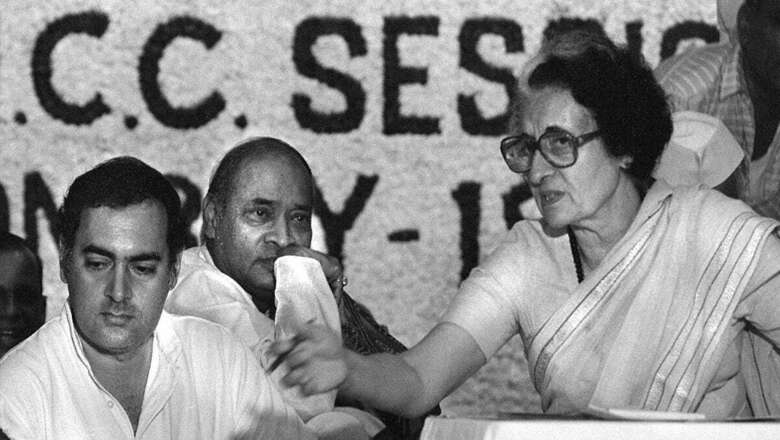
views
Sam Pitroda’s casual comment on utility and perhaps also the necessity of inheritance tax in India during an interview has triggered a national debate on the economic direction the Congress is willing to take India to, if given the chance. The tax issue has further emboldened the BJP’s counterattack on the Congress, and the BJP is using it with all its manoeuvres.
The impracticality of certain promises in the Congress manifesto and sheer pandering to identities – religious as well as caste – betrays the underlying desperation of the Congress party to somehow be relevant in the elections. Rahul Gandhi has ensured that the Congress is at its nadir since the inception of the grand old party and he is intelligibly doing everything that would save the face for him and his party. And desperate times call for desperate measures! In the case of the Congress party, it is the recourse to populist and arguably divisive identity politics.
The Congress flirting with social populism and identity politics should not surprise us beyond a point. History suggests that the grand old party has always used these political tactics for its own survival and also, more importantly, for the revival of the Gandhi dynast within the Congress. What is however worrisome is that almost every time the Congress resorted to it, it had severe consequences for India.
The socialist cauldron that Nehruvian economics pushed the Indian economy into was premised on the marginalisation and further exodus of the liberal voices from the Congress – voices which could have checked the excesses of state interference in the economy. John Mathai’s famed exit from Nehru’s cabinet after presenting the 1950 budget in protest of the excessive centralisation of power in the state and unconstitutional incorporation of the ‘Planning Commission’ is just one case in point. But even then, Nehru nominally sported the trope of mixed economy which suggested that private capital and relatively free enterprise and state control can co-exist in a mutually fulfilling way. The reality however was the State was comfortably being entrenched beyond a point, the consequences of which were disastrous for India in the decades to follow.
The economy further plummeted into the socialist gallows when Mrs Gandhi, in an effort to trump over the syndicate, allied with the socialist radicals within the party to sail through inner-party factionalism. The context here was the declining electoral results of the Congress, evident from the 1967 elections, and also the decline of the relative significance of Mrs Gandhi within the party in front of rivals like Morarji Desai. Mrs Gandhi’s cunning socialist turn was a strategy to revive her political fortunes – both within the Congress and also nationally. This was facilitated by the radicals within the Congress who wanted a radical reorientation in the Congress’ economic outlook.
The ‘Young Turks’ – as they were called then – led by Chandra Sekhar of Praja Socialist Party assisted, or rather entirely navigated, Mrs Gandhi to adopt the policies that would take India in the direction of a socialist state. Indira Gandhi’s ten-point program, which was a carbon copy of the Young Turk’s blueprint for the Indian economy, was the indication of the decisive departure from a symbolic mixed economy championed by Nehru to a highly state-controlled and dictated one.
Mrs Gandhi’s tactical adoption of social populism through the rhetoric of Garibi Hatao and through policies like nationalisation, Monopolistic and Restrictive Trade Practices (MRTP) was premised more on the political calculations of her own survival than on the genuine assessment of India’s economic needs. That Indira’s government in this phase was supported by the Left parties made the issues even more problematic. After the dismal performance of the Janata government, when Mrs Gandhi came to power once again without the compulsions of the Left, she finally started the process of reforming the economy when she realised the revival through socialist principles was almost impossible.
The modernist Rajiv Gandhi, who nurtured no lost love for the outdated economic principles adopted by her mother earlier, took forward her reformist initiatives on the economy, though not with the urgency the situation would have demanded. The consequence was an impending economic crisis. Rajiv Gandhi however played with the diabolic game of identity politics to appease a section of community he thought was central to Congress’ political fortunes.
The Shahabuddin and the Shah Bano blunder that his government got into dented the secular mask of the Congress at a point of no return. Not that the Congress was genuinely secular before, but the appeasement earlier had a veneer of subtlety before Rajiv openly flirted with competitive communalism in the case of Shah Bano and later with the opening of the gates of Ramjanmabhoomi. Little did he know that, in the process, he was supporting the political force which would go on to challenge the Congress nationally. It took Narasimha Rao, a non-Gandhi PM from the Congress assisted by the reformist economist Dr Manmohan Singh, to finally put to rest the controlled economy and pave the way for economic independence India desired and deserved.
The sagacity of Dr Singh was to continue on the path of the economic direction of his predecessor Vajpayee, which yielded strong economic dividends for Dr Singh’s government. Congress’ victory in 2009, despite the disastrous 2008 terror attacks in Mumbai, was a result of Manmohan Singh’s economic performance. In the process, he had battled hard against the imperious National Advisory Council (NAC), which was an unconstitutional body housed with the cronies of the dynast, which attempted to derail the Singh government’s reformist agendas.
Manmohan Singh invested a lot of personal and political capital to have an upper hand over the NAC, the successful completion of the nuclear deal is just an example of that. In the second tenure, however, the NAC was successful in pushing down the throat of the Singh government the policies which were closer to the dynast. The political objective was clear once again.
This was the time when the Congress guard was attempting to catapult a non-performing, incompetent Rahul Gandhi to lead the Congress in upcoming general elections. The embrace of socialistic principles once again was aimed at projecting Rahul as an emerging leader of Congress with a pro-poor socialist agenda. The economic meddling by the NAC, coupled with crony capitalism facilitated by a dysfunctional UPA II, led to a crippled economy and resulted in the complete decimation of the Congress in 2014 general elections.
Now, when the Congress is literally fighting the battle of survival and relevance, it is returning to the old trick from its kitty, albeit with the scale of concoction that is unprecedented by its own standards in the past. Congress’ manifesto and the speeches by its leaders once again suggest that it is flirting with the toxic combination of social populism and divisive identity politics, masked under the convenient garb of social justice, to put up a fight for its survival. The Congress, helmed by Rahul, tested these tactics in the Karnataka Assembly elections earlier. Emboldened by its success in Karnataka, the rhetoric is now loud and shrieking, replete with regressive religious appeasement, divisive caste-based utterance and allusion to the redundant calls, subtle or otherwise, to the disastrous idea of ‘wealth redistribution’.
Whatever revolutionary ways Rahul is talking about falls flat on the credentials of the Congress party given its record in dealing with the economy in the past. In fact, data suggests that the nature of income inequality may have been worse in the two UPA eras as compared to the NDA, essentially before the Covid-19 outbreak. And the record of dealing with crony capitalism during the UPA is not very inspiring when we look at the series of scams that brought the Congress government to its heel. The subsequent defeats of the Congress in elections have pushed the party to the extent that its relevance is not being questioned in the political space today.
The reorientation to divisive sectarian and casteist rhetoric in the manifesto as well in the campaign trail is a desperate attempt by the Congress to hop on to any possible mechanism to have a saving grace in the upcoming elections. But it is important to debate this narrative that is being peddled by the party and talk about the consequences of this newly invigorated populism and identity politics to our country.
Wealth inequality is a major problem, there is no doubt about it. But it is also important to understand that it is the systemic problem of the Indian economy which needs systemic answers and not the outdated troupe about wealth redistribution and enforced equality. Congress’ full-throttle pushing of social populism and divisive identity politics is a parochial way to secure votes by instigating fears – a trick they have used well in history. Whether it will save the Congress or push the party into further obscurity, only time will tell. But it is important to call out these divisive and self-destructing strategies which Congress is using, because, if history is anything to go by, the consequences of such policy actions are bound to be disastrous.
The author is Assistant Professor (Politics & International Relations) at Symbiosis School for Liberal Arts. Views expressed in the above piece are personal and solely that of the author. They do not necessarily reflect News18’s views.














Comments
0 comment